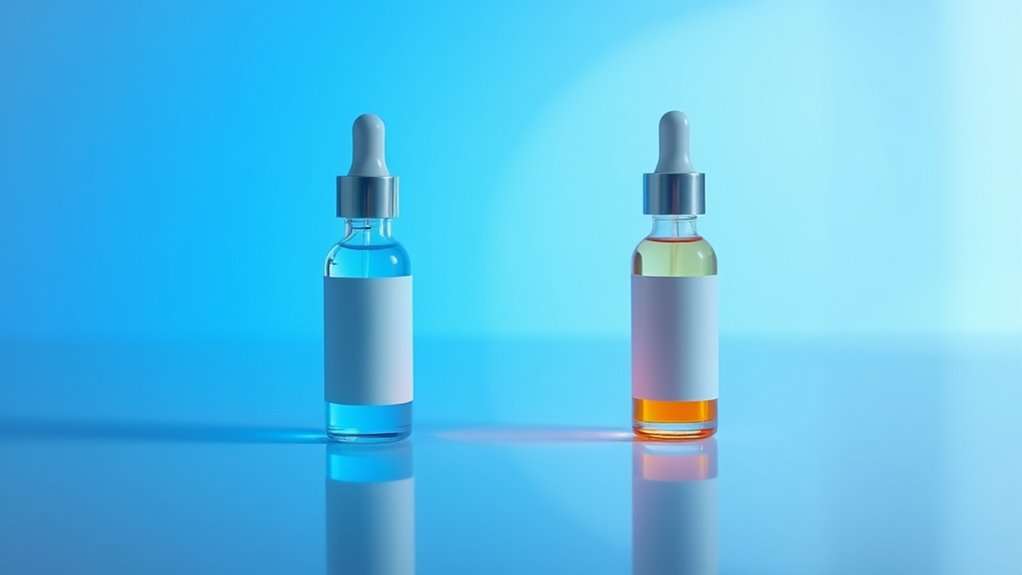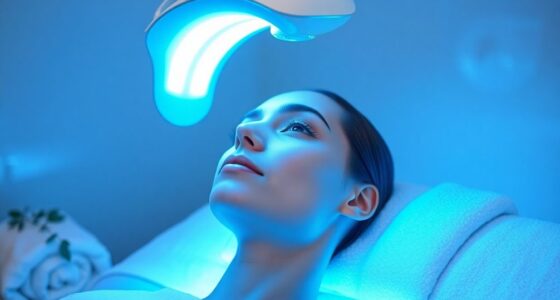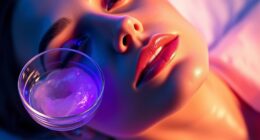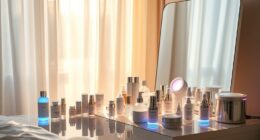If you want faster results, benzoyl peroxide works quickly by directly killing bacteria and unclogging pores, often showing improvements within days. Blue light therapy, on the other hand, is gentler and gradually reduces bacteria and inflammation over several weeks. If you’re concerned about skin sensitivity or prefer a less aggressive approach, blue light might be better for you. Keep exploring to find out which option suits your skin type best.
Key Takeaways
- Benzoyl peroxide often shows faster results, clearing skin within a few days to a week.
- Blue light therapy typically requires multiple sessions over several weeks for noticeable improvement.
- Benzoyl peroxide rapidly reduces bacteria and inflammation, leading to quicker visible effects.
- Blue light therapy is slower but offers a gentler, less irritating treatment option.
- Combining both treatments under professional guidance can accelerate overall acne improvement.
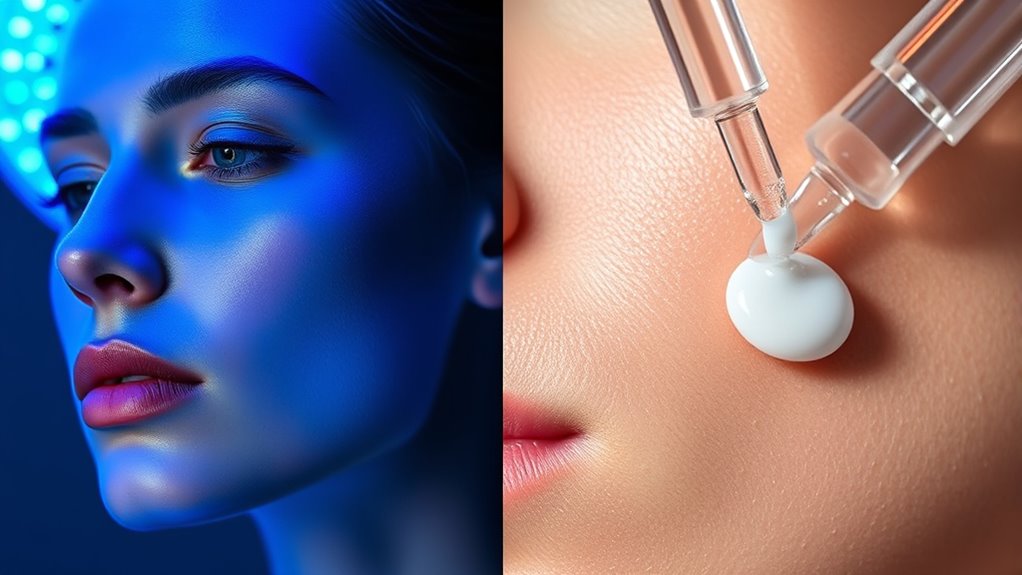
When it comes to treating acne, both blue light therapy and benzoyl peroxide are popular options, but they work in different ways. Blue light therapy uses specific wavelengths of light to target the bacteria responsible for acne, especially Propionibacterium acnes. This method is non-invasive and often performed in clinics or with at-home devices. Since light therapy primarily targets bacteria and reduces inflammation, it can help clear your skin gradually without harsh chemicals. However, not everyone responds immediately; some see improvements after several sessions. One thing to contemplate is skin sensitivity. Blue light therapy is generally gentle, but if you have sensitive skin, you might experience some redness or irritation post-treatment. That said, it’s usually less irritating than topical treatments, making it a good choice if your skin tends to react badly to creams or chemicals. Additionally, the attention you give to your skin during treatment can influence its effectiveness, emphasizing the importance of consistent care. Benzoyl peroxide, on the other hand, is a topical medication that kills bacteria directly and helps unclog pores. It’s been a staple in acne treatment for decades because of its proven effectiveness. When you apply benzoyl peroxide, it penetrates deep into your pores, reducing bacteria levels rapidly and decreasing inflammation. The downside is that it can cause skin irritation, dryness, peeling, and especially skin sensitivity. If your skin is already delicate, you might find that benzoyl peroxide exacerbates redness or causes a burning sensation. To minimize these effects, it’s essential to start with lower concentrations and gradually increase usage, always following your dermatologist’s advice. In terms of speed, benzoyl peroxide tends to work faster in killing bacteria and reducing active breakouts because it acts directly on the source. You might notice clearer skin within a few days or a week. Blue light therapy, however, usually requires multiple sessions over several weeks to see significant results, making it a slower option. But for some, the gentler approach of light therapy means fewer side effects, especially if skin sensitivity is a concern. It’s also worth noting that combining treatments—using light therapy alongside topical benzoyl peroxide—can sometimes provide faster, more all-encompassing results, but this should only be done under professional guidance. Moreover, understanding the role of creative practice in exploring different treatment options can help you approach your skincare routine with patience and curiosity. Ultimately, your choice depends on your skin type, sensitivity, and how quickly you want to see results. If you have sensitive skin or are wary of irritation, light therapy might be a safer, less aggressive route. If you need rapid bacterial reduction and don’t mind the potential side effects, benzoyl peroxide could be more effective. Either way, consulting with a dermatologist can help you develop a tailored plan that suits your skin’s needs and helps you achieve clearer skin efficiently.
Frequently Asked Questions
Can Blue Light or Benzoyl Peroxide Cause Skin Photosensitivity?
You should know that both blue light and benzoyl peroxide can cause photosensitivity risks, making your skin more sensitive to sunlight. This means you need to be cautious with sun exposure during treatment. They might also affect treatment compatibility, so it is crucial to follow your dermatologist’s advice. Using sunscreen daily and avoiding direct sunlight can help protect your skin and maximize treatment effectiveness.
Are There Any Long-Term Side Effects From Using Blue Light Therapy?
You’re wondering about the long-term effects of blue light therapy. While it’s generally safe, some people may experience skin dryness, redness, or irritation over time. There’s limited research on extended use, so it’s best to consult your dermatologist regularly. Long term effects are still being studied, but most users tolerate blue light well if used appropriately. Staying informed and monitoring your skin’s response helps minimize potential risks.
How Do I Determine Which Treatment Is Best for My Skin Type?
To determine which treatment suits your skin type, consider your skin’s compatibility and needs. You should consult a dermatologist who can assess your skin’s condition and recommend personalized options. Treatment customization is key—some treatments work better for oily or sensitive skin. Pay attention to how your skin reacts and follow professional advice for the safest, most effective approach tailored specifically for you.
Is There a Risk of Antibiotic Resistance With Benzoyl Peroxide?
You might wonder if benzoyl peroxide leads to antibiotic resistance. While it’s effective against acne-causing bacteria, it doesn’t usually cause antibiotic resistance like antibiotics do, because bacteria don’t develop resistance through bacterial mutation with peroxide. However, overuse can reduce effectiveness over time. To stay safe, follow your dermatologist’s instructions and avoid excessive use, ensuring you treat acne without risking bacterial mutation or resistance development.
Can These Treatments Be Combined for Faster Results?
Like a symphony, combining treatments can enhance your acne battle. Combination therapy with blue light and benzoyl peroxide often speeds up results, but you need to take into account skin compatibility. Some skin types might react poorly, causing irritation. Always consult your dermatologist to tailor a plan that maximizes benefits while minimizing risks. Properly coordinated, these treatments can work together harmoniously for clearer skin faster.
Conclusion
Think of blue light and benzoyl peroxide as two different knights fighting the same dragon—acne. Blue light is like a swift archer aiming precisely, often working faster on mild cases. Benzoyl peroxide, meanwhile, is the brave knight wielding a sword, tackling stubborn acne head-on. Depending on your skin’s battle, choose your champion wisely. Whichever you pick, remember, patience and consistency are your strongest allies in winning the war against acne.
